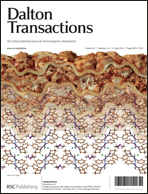A novel sulfur-terminal Cd(II) complex, CdS2L (L = N-hexyl-3-{2-[4-(2,2′:6′,2′′-terpyridin-4′-yl)phenyl]ethenyl}-carbazole), was successfully synthesized from CdS nanocrystals and the organic chromophores (L), which was confirmed by single-crystal X-ray diffraction analysis. Its photophysical properties have been investigated both experimentally and theoretically. The novel hybrid nanoparticles (CdS/L) were then obtained using the L as surface capped agent, which aggregate into large spheres, exhibiting novel luminescent properties, strong two photon absorption (TPA) and obvious prolonged fluorescence lifetime, which differ from those of the pure CdS nanocrystals and free L.
You have access to this article
 Please wait while we load your content...
Something went wrong. Try again?
Please wait while we load your content...
Something went wrong. Try again?


 Please wait while we load your content...
Please wait while we load your content...